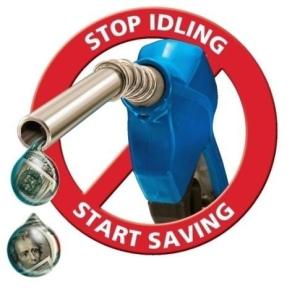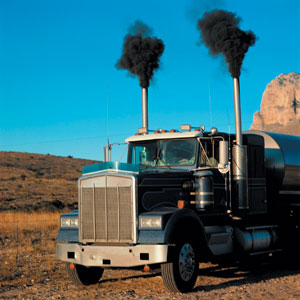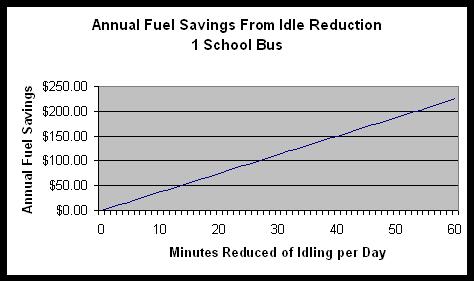Idling Law Goes Unnoticed
How many people know there’s a no-idling law in Massachusetts? It’s been on the books since 1972. Yet, I’ve lived in Massachusetts for over 25 years and never knew about it.
 I stumbled across it one very hot day a few weeks ago after I watching a town employee leave a town vehicle idling in the parking lot behind Town Hall while he worked on the grounds around Town Hall. (Important note: according to the Highway Superintendent, this type of idling is against Highway Department policy, and this was a rogue employee.) Annoyed by the waste of gas (particularly since I had just received our tax bill!) and the added smog to the already sweltering day, I turned back towards Town Hall to see if Holliston had an anti-idling ordinance. In Somerville, where I lived previously, there is an actively-promoted and enforced anti-idling ordinance (necessary for that very dense city). Holliston does not have one and I began to research the issue. That was when I found the Massachusetts anti-idling statutes and regulations.
I stumbled across it one very hot day a few weeks ago after I watching a town employee leave a town vehicle idling in the parking lot behind Town Hall while he worked on the grounds around Town Hall. (Important note: according to the Highway Superintendent, this type of idling is against Highway Department policy, and this was a rogue employee.) Annoyed by the waste of gas (particularly since I had just received our tax bill!) and the added smog to the already sweltering day, I turned back towards Town Hall to see if Holliston had an anti-idling ordinance. In Somerville, where I lived previously, there is an actively-promoted and enforced anti-idling ordinance (necessary for that very dense city). Holliston does not have one and I began to research the issue. That was when I found the Massachusetts anti-idling statutes and regulations.
 Walking around town I’ve seen a lot of cars idling outside of buildings, while people run in to a store to buy something, sit in them to do work, or wait to pick up kids. Sometimes I see large trucks idling on the road for no apparent reason (they are not using engine-powered electrical equipment in the truck, etc.). The information provided below is not intended to be legal advice, but to provide public awareness of the environmental and health consequences of unnecessary idling and the state laws and regulations addressing it. Some of the information comes directly from the Massachusetts Department of Environmental Protection:
Walking around town I’ve seen a lot of cars idling outside of buildings, while people run in to a store to buy something, sit in them to do work, or wait to pick up kids. Sometimes I see large trucks idling on the road for no apparent reason (they are not using engine-powered electrical equipment in the truck, etc.). The information provided below is not intended to be legal advice, but to provide public awareness of the environmental and health consequences of unnecessary idling and the state laws and regulations addressing it. Some of the information comes directly from the Massachusetts Department of Environmental Protection:
INFORMATION ABOUT THE MASSACHUSETTS ANTI-IDLING LAWS AND REGULATIONS
Idling vehicles pollute the air and present several health and environmental hazards.
Gasoline and diesel vehicles produce carbon monoxide, carbon dioxide, volatile organic compounds (VOCs) and oxides of nitrogen (NOx). Carbon monoxide causes respiratory distress and in high concentrations can be lethal; carbon dioxide is a primary contributor to global warming; and VOCs and NOx and form ozone, ground level smog and impair lung function. In addition, diesel exhaust contains fine particulate matter, which the U.S. Environmental Protection Agency has designated as a likely carcinogen. The elderly, chronically ill and children are all particularly vulnerable to these health effects because their lung function is respectively decreased, impaired or still in development.
In addition, Massachusetts General Law (G.L. Chapter 90, Section 16A) and the Massachusetts Department of Environmental Protection (DEP) idling reduction regulation (310 CMR 7.11(1)(b)) both prohibit unnecessary vehicle idling. To provide additional protections for children, G.L. Chapter 90, Section 16B and 510 CMR 27.01-27.07 further restrict unnecessary idling in school zones.
Penalties can range from $100 (G.L. Chapter 90, Section 16A) to as much as $25,000 (G.L. Chapter 111, Section 142A). Drivers and/or companies can be held responsible for paying the fine and local police have the authority to enforce the law, as do health officials or other officials who hold enforcement authority.
.General Prohibition of Unnecessary Idling over Five Minutes
Massachusetts General Law chapter 90, section 16A and 310 CMR 7.11 prohibit “unnecessary operation of the engine of a motor vehicle while said vehicle is stopped for a foreseeable period of time in excess of five minutes.” This prohibition does not apply to (a) vehicles that are being serviced (if running the engine is necessary for the service); (b) delivery vehicles delivering goods that require engine-generated power (such as a refrigeration); or (c) vehicles engaged in operations in which the engine power is necessary and if such power does not contribute to air pollution.
The punishment for a violation of this statute for a first offense is $100 and, for second or subsequent violations, not more than $500. Air pollution in general is punished by G.L. ch. 111, section 142A, and carries fines up to $25,000.
 Prohibition of Unnecessary Idling on School Grounds.
Prohibition of Unnecessary Idling on School Grounds.
Massachusetts General Law chapter 90, section 16B pertains specifically to vehicles on school grounds. The purpose of restricting idling near school grounds is to improve and protect school campus air quality. This law is more restrictive -- it restricts all unnecessary idling (not
only idling over five minutes) -- and carries a greater penalty for violations ($100 for a first offense and a mandatory $500 for a second and subsequent offense). Section 16B prohibits all unnecessary idling of motor vehicles within one hundred feet of a “public or private accredited preschool, accredited Head Start facility, elementary, vocational or secondary school whether or not in session, and shall include any athletic field or facility and any playground used for school purposes or functions which are owned by a municipality or school district, regardless of proximity to a school building, as well as any parking lot appurtenant to such school, athletic field, facility or playground.”
 It also prohibits any idling within 100 feet of “a known and active school air intake system, unless the school has determined that alternative locations block traffic, impair student safety or are not cost effective.” Schools should alert individuals to these areas with signs.
It also prohibits any idling within 100 feet of “a known and active school air intake system, unless the school has determined that alternative locations block traffic, impair student safety or are not cost effective.” Schools should alert individuals to these areas with signs.
Section 16B does not apply when idling is necessary in the following situations described below:
- Traffic Conditions.
- For traffic conditions over which the driver has no control; or
- For an official traffic control device or signal; or
- At the direction of a uniformed police officer or a person authorized to direct traffic.
- Queuing at a School.
- Where the physical configuration of a school requires a queue of vehicles for the sequential discharge or pickup of students, and the queue of vehicles is actively engaged in the discharge or pickup of students.
- Turbo-charged Diesel Engine Cool Down or Warm Up. When the manufacturer’s specifications require idling the engine, to cool down or warm up a turbo-charged diesel engine. Documentation of this requirement shall be kept in the vehicle at all times.
- Cold/Hot Weather - School Buses.
- If the interior temperature of any school bus is less than 35°F, then idling is allowed to heat the interior of the school bus for a period or periods aggregating not more than three minutes in any 15 minute period during which the school bus is waiting to accept or discharge passengers; or
- If the interior temperature of any school bus is greater than 80°F and it is not practical or possible to open the windows or to park in a shaded area, and the school bus is equipped with air conditioning, then idling is allowed to cool the interior of the motor vehicle for a period or periods aggregating not more than three minutes in any 15 minute period during which the school bus is waiting to accept or discharge passengers.
- Cold/Hot Weather - Motor Vehicles Other Than School Buses.
- If the exterior temperature is less than 35°F, then idling is allowed to heat the interior of any motor vehicle other than a school bus for a period or periods aggregating not more than one minute in any 15 minute period during which the motor vehicle is waiting to accept or discharge passengers; or
- If the exterior temperature is greater than 80°F and it is not practical or possible to open the windows or to park in a shaded area, and the vehicle is equipped with air conditioning, then idling is allowed to cool the interior of the motor vehicle other than a school bus for a period or periods aggregating not more than one minute in any 15 minute period during which the motor vehicle is waiting to accept or discharge passengers.
- Safety and Emergencies.
- To ascertain that the school bus or other commercial vehicle is in safe operating condition and equipped as required by all provisions of law, and all equipment is in good working order, either as part of the driver’s daily vehicle inspection, or as otherwise needed; or
- To operate the flashing signal lamps and/or stop signal arm devices required by law where the operation of those devices cannot be undertaken by battery power alone; or
- To operate defrosters, or other equipment to ensure the safe operation of the vehicle, or as otherwise required by federal or state motor carrier safety regulations, or other local requirements; or
- To operate a heater or an air conditioner for only the period necessary to ensure a reasonable interior temperature in a vehicle that has, or will have, one or more children aboard with temperature sensitive disabilities; or.
- To operate a lift or other piece of equipment designed to ensure safe loading, unloading, or transport of persons with one or more disabilities; or
- Use of school bus as an emergency vehicle.
- Maintenance of Operations.
- For testing, servicing, repairing, or diagnostic purposes; or
- To recharge a battery or other energy storage unit of a hybrid electric bus.
COMMON QUESTIONS
Are there other times when it’s OK to idle not listed in the law?
G.L. ch 90 section 16A prohibits unnecessary idling, then lists three exemptions to that rule. So there are other times when idling is permitted as long as the idling is absolutely necessary.
For example, running the engine to operate the windshield defroster to clear a windshield of ice on an extremely cold day is a good example of necessary idling. It’s a safety problem if you cannot see where you’re going and if the windshield is not warm enough to melt snow and freezing rain while driving. Running the engine while actively clearing snow and ice off the vehicle and to warm the windshield and interior of the vehicle is necessary idling. Our common sense also tells us that heaters and air conditioning units almost always bring the vehicle’s interior into a comfortable range in a short time. We also know that heaters and air conditioning units work faster when the vehicle is being driven, not when it is left idling. So most vehicles, most of the time, will reach a comfortable temperature within the
first five minutes of driving. Some heavy vehicles, such as buses or trucks, may need some additional time to bring interior temperatures into a comfortable range.
What are a few examples of unnecessary idling?
- Sitting in your car in a parking lot with the engine on during mild or cool weather is unnecessary. The interior of your car will stay warm for 5 to 10 minutes on all but the coldest days.
- Leaving the vehicle running while unattended to let the heater warm it or the air conditioner cool it for extended periods of time is unnecessary idling (it is also in violation of motor vehicle law). Five minutes should be the maximum amount of time unless weather conditions are extreme, and the engine should not be left running while the vehicle is unattended for any length of time.
- Operating devices not related to transporting passengers or goods. Letting the engine run for an hour or more to play a movie or to charge a cell phone causes unnecessary pollution, is a nuisance for others nearby and puts excessive wear and tear on the engine.

Am I causing more pollution by stopping and starting the engine?
No. Once the engine has warmed up, an idling engine causes more pollution by running than by stopping and starting up again. Studies indicate that the trade-off for light- and medium-duty gasoline powered vehicles is about 10 seconds (i.e., the vehicle will produce more pollution idling longer than 10 seconds than it will by shutting down and restarting the engine). The time trade-off on medium- and heavy-duty diesel engines is about 30 seconds.
Won’t I wear out my starter if I keep stopping and starting the engine?
Fleet managers of companies with strict anti-idling policies report that they do not replace starters in their vehicles more frequently than vehicles that are left running for extended periods. In fact, more damage occurs to engines that are left idling over long periods of time.
Who would I complain to if I see a vehicle idling unnecessarily?
The best place to start is your local Board of Health. Other possibilities include local police, DEP or the EPA. Enforcement personnel cannot respond to every complaint about idling vehicles, and there are instances when it is not obvious why a vehicle needs to idle. But many of the complaints about excessive idling are about the same vehicles in the same locations routinely left idling, many times out of habit. For people living or working near those vehicles the exhaust that they are subjected to is not just a nuisance, it’s a real health problem.
Do the Anti-idling law and regulation apply to all vehicles?
The law and regulation apply to all motor vehicles. All motor vehicles contribute to air pollution and can create a nuisance if the exhaust is affecting others.
Ambulances remain 'mission-ready' without idling when using the Medidock! www.medicaire.net
Frank Podgwaite | 2017-03-02 09:49:40
On a cold morning with somewhat humid air a school bus windshield will be loaded with heavy frost..To expect drivers to climb up onto the hood to c scrape it off is totally foolish and dangerous, the defrost spray that comes in a can may clear the windshield up and when you move the bus it evaporates and makes matters worse..The only logicle way to defrost a windshield is to use the defroster, when a bus reaches operating temperature the thermostat will open and allow warm water to run the defroster properly..To think this can be done in five min. is a joke and the fools who made this law are totally uninformed..A minimum of 15 min are required to properly get the defroster operating properly..Its time massachusetts passed the same law that Minnasota has in regards to defrosting windshields re
Alan Lyons | 2016-12-09 08:06:31
What about truckers? Even with clean-idle certified trucks with DEF and DPF, there's no exception so they can run their heaters when it's 20 degrees. Could you sleep in 20 degree weather? Could you drive for 11 hours if you had to wake up hourly to run the heat for 5 minutes? DOT regulations require truckers to get an uninterrupted period of sleep, so following this law is actually a criminal act. When a trucker falls asleep at the wheel and kills your family, you might think about this law a little harder
Robert W | 2016-01-02 14:50:19
Wow, great article! I will be sure to turn my car off when I'm waiting outside of a building from now on.
Arlene Walsh | 2014-08-06 18:40:46
Good article, now if we could get people to use their headlights when it's raining we'd be able to see them better. New York has a law; "Wipers on, Lights on".
Herb Krauss | 2014-08-05 04:11:37